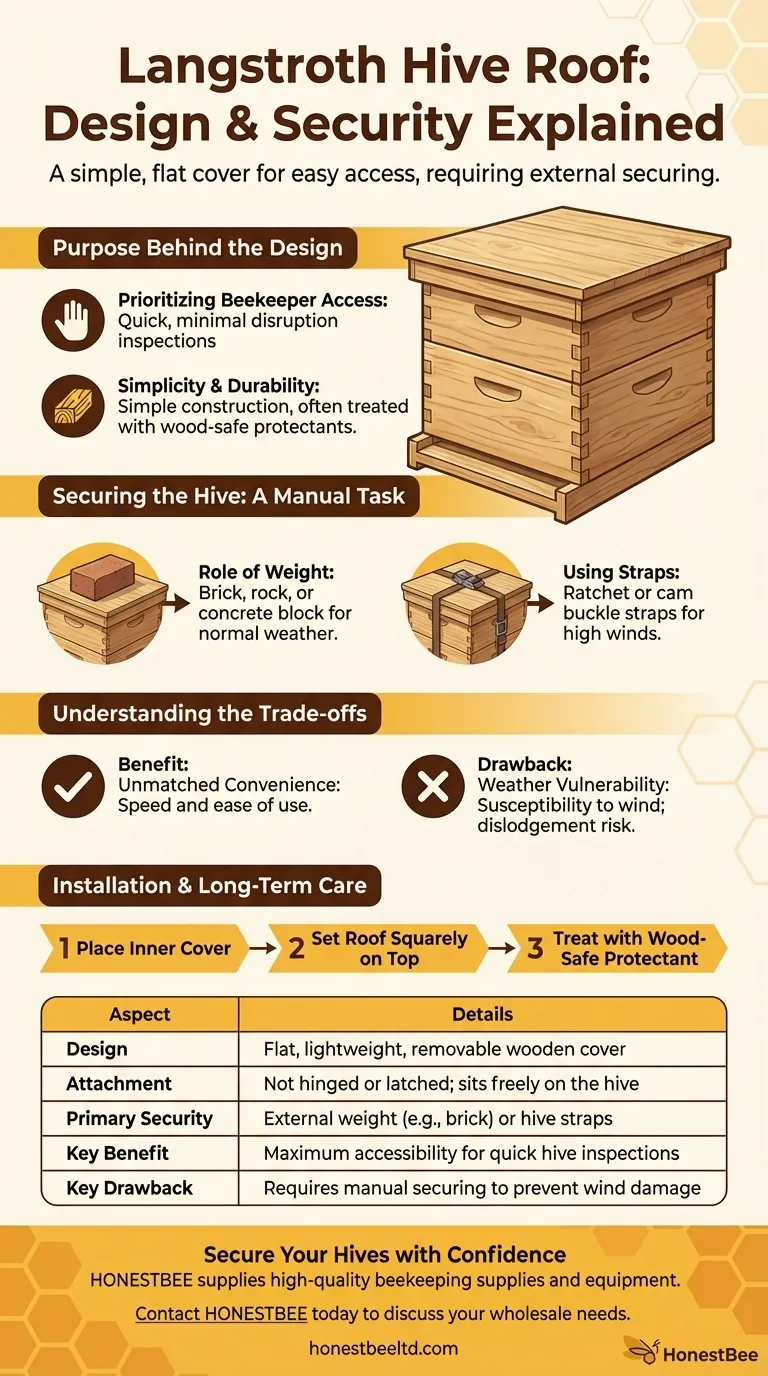A Langstroth hive roof is a simple, flat cover designed for easy removal. It sits on top of the uppermost hive box (super) and is not attached with hinges or latches. Because it is lightweight, it must be secured externally with a heavy object like a brick or with hive straps to protect it from being dislodged by high winds.
The Langstroth roof design intentionally sacrifices built-in security for maximum accessibility. Its lightweight, unattached nature is a core feature that simplifies hive inspections, but it places the responsibility for securing it against the elements directly on the beekeeper.

The Purpose Behind the Design
The simplicity of the Langstroth roof is not an oversight; it is a key component of a modular and accessible system. Understanding its purpose clarifies why it is designed the way it is.
Prioritizing Beekeeper Access
The primary goal of the Langstroth hive is to allow the beekeeper to inspect and manage the colony with minimal disruption.
A lightweight, easily removable roof means you can access the hive components in seconds, making tasks like feeding, checking for pests, or adding another super quick and efficient.
Simplicity and Durability
The flat design is simple to construct and maintain. The wood is often treated with a protective substance like tung oil, which shields it from the elements for many seasons without introducing chemicals into the hive environment.
Securing the Hive: A Manual Task
Because the roof is not physically attached, you must provide the security yourself. The method you choose depends on your local climate and conditions.
The Role of Weight
For most situations, the simplest solution is the most common. Placing a heavy brick, large rock, or concrete block on the center of the roof is often enough to keep it in place during normal weather.
Using Straps for Added Stability
In areas prone to high winds or significant storms, straps are a more reliable option. A ratchet strap or cam buckle strap can be cinched around the entire hive, from the roof to the bottom board, binding all the components tightly together.
Understanding the Trade-offs
The design of the Langstroth roof presents a clear trade-off between convenience and security.
The Benefit: Unmatched Convenience
The key advantage is speed and ease of use. You never have to fumble with latches or hinges, which is especially valuable when you are wearing gloves and trying to work efficiently.
The Drawback: Weather Vulnerability
The obvious downside is its susceptibility to wind. A dislodged roof can expose the colony to rain, cold, and pests, which can be devastating. Forgetting to secure the roof after an inspection is a common and costly mistake for new beekeepers.
Installation and Long-Term Care
Proper placement and maintenance ensure the roof does its job effectively for years.
How to Place the Roof
Installation is straightforward. First, place the inner cover directly on the top hive box. Then, simply set the main roof squarely on top of the inner cover.
Protecting the Roof for Durability
To maximize the life of your wooden roof, treat it with a wood-safe protectant. Applying a coat of tung oil, for example, helps seal the wood against moisture, preventing rot and extending its functional lifespan.
Making the Right Choice for Your Goal
Securing the hive is a non-negotiable part of beekeeping. The method you use should be based on your specific environment.
- If your primary focus is simplicity in a low-wind area: A heavy object like a brick or paver provides sufficient security with zero effort.
- If your primary focus is maximum security in a high-wind area: Using a dedicated hive strap is the most reliable way to ensure your hive remains sealed during severe weather.
Ultimately, managing a Langstroth roof is a simple but critical task that directly protects the health and integrity of your colony.
Summary Table:
| Aspect | Details |
|---|---|
| Design | Flat, lightweight, removable wooden cover |
| Attachment | Not hinged or latched; sits freely on the hive |
| Primary Security | External weight (e.g., brick) or hive straps |
| Key Benefit | Maximum accessibility for quick hive inspections |
| Key Drawback | Requires manual securing to prevent wind damage |
Secure Your Hives with Confidence
Protecting your investment is paramount. For commercial apiaries and distributors managing multiple hives, reliable, durable equipment is non-negotiable. HONESTBEE supplies high-quality beekeeping supplies and equipment, including sturdy hive components designed for long-term use in demanding conditions.
Let us help you build a more resilient and productive operation. Contact HONESTBEE today to discuss your wholesale needs and discover our full range of commercial-grade solutions.
Visual Guide

Related Products
- Long Langstroth Style Horizontal Top Bar Hive for Wholesale
- Professional Insulated Winter Hive Wrap for Beekeeping
- Langstroth Bee Hives Bee Keeping Box for Beginners Beekeeping
- Inner Beehive Cover for Beekeeping Bee Hive Inner Cover
- Ergonomic Two Person Foldable Hive Lifter
People Also Ask
- How does the top bar hive help control varroa mites? A Natural Approach to Mite Management
- How does the design of a top bar hive benefit beekeepers? Ergonomic & Natural Beekeeping for Hobbyists
- What are the main differences between Langstroth hives and top bar hives? Choose the Right Hive for Your Beekeeping Goals
- What are the benefits of a top bar hive? A Natural, Low-Impact Approach to Beekeeping
- What are the most popular types of hives besides the Langstroth? Top Bar & Horizontal Hives Explained



















